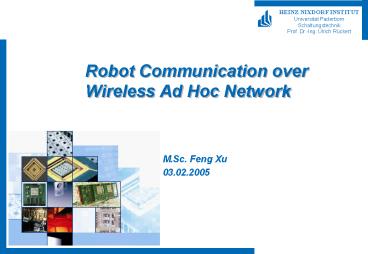Robot Communication over Wireless Ad Hoc Network - PowerPoint PPT Presentation
1 / 18
Title:
Robot Communication over Wireless Ad Hoc Network
Description:
MANET is a decentralized wireless network without pre-built infrastructure ... MANET may operate in a standalone fashion, or may be connected to other existent ... – PowerPoint PPT presentation
Number of Views:74
Avg rating:3.0/5.0
Title: Robot Communication over Wireless Ad Hoc Network
1
Robot Communication over Wireless Ad Hoc Network
- M.Sc. Feng Xu
- 03.02.2005
2
Agenda
- Why communication among robots is necessary
- 3 examples
- Two categories network centralized network and
ad hoc network - Properties of ad hoc network, and examples
- Current Main Stream Techniques
- Hardware structure for the communication node
- Constrains for portable devices energy, space,
computing ability - MAC protocol, CSMA/CA
- Current two hot research directions on MAC layer
- Directional communication
- Dynamic multi-channel allocation
- 3 means to close the gap between theory and
realization - Summary
3
Why communication among Robots
- Goal of RoBoCup To fully develop autonomous
humanoids that can win against human world
champion soccer team by 2050 - Each robot player should have more powerful
individual ability over human player - Communication among robots is necessary for the
high level coordination (deliberation-based high
level behavior control!) - In special robot application scenarios like war
field and emergency field, communication among
robots can significantly enhance their ability - Contrariwise, robots with wireless communication
module can help simulate or experiment the
wireless network
4
Example 1, AIBO
5
Example 2, BiM-2
Receiver on a PCB
Receiver unit on a robot
Seattle University RoboCup Team, USA
6
Example 3, Khepera
7
Two Categories of Network
Centralized Network
8
Properties of Ad Hoc Network, examples
Properties
- MANET is a decentralized wireless network without
pre-built infrastructure - Each node acts as host and router simultaneously,
and signals may be transmitted via multi hop to
the destination - The network topology may change rapidly and
unpredictably due to movements, joining and
leaving of nodes at any moment - MANET may operate in a standalone fashion, or may
be connected to other existent network as its
extension
Examples
- Conferencing and home networking
- Wireless sensor network
- Multi-hop extensions for cellular
telecommunication systems - And networks of vehicles, robots
9
Current Main Stream Techniques
- Bluetooth
- WLAN IEEE 802.11 b,g,a
- HiperLAN/II
- ZIgBee
- WiMax (near future)
10
Hardware Structure, different network layers
Baseband Processor
MAC controller
RF transceiver
physical
MAC
Host
Hardware structure for each node
other high layers
OSI/ISO Reference Model
11
Constrains for Portable Devices
- Physical space
- Limited energy (battery powered devices)
- Limited computing power
12
CSMA/CA
- MAC protocol carrier sense multiple access
with collision avoidance - Prerequisites Omnidirectional communication on
single frequency channel
RTS, CTS, data and NAV setting
Resulted space allocation condition
Basic media access process
13
Current hot research topics
- Goals
- Increase resource efficiency, the resource mainly
means frequency band - Make the communication link more robust
- Means
- Directional communication to increase the space
reuse factor - Multi-channel dynamic allocation scheme
14
Smart Antenna, directional antenna
- Smart Antenna
- Realized by antenna array and additional array
signal processing unit - Enable various advantages on network, but also
consume much additional resource like space,
energy and computing power - Directional Antenna
- The directivity is attributed to the directional
property of the antenna element itself - With the mechanical turning assistance, or
multiple directional antennas equipped on each
node with proper orientation, each node can
communicate on the direction it wishes - Less additional resource is needed comparing to
SM, however, less improvement is anticipated
15
Multi-channel scheme CDMA, OFDM
16
Theoretical Research, Practical application, 3
means close the gap
- Theoretical research
- New schemes are firstly put forward on the
physical layer - Higher layers (MAC, network layers) need adapting
to the modifications - Cross-layer optimization
- Close the gap between theoretical research and
practical application - In practice, many constrains are imposed
- Rely on the chip layer improvement
- Use the simplified scheme to make it more
practical - The combination of aforementioned 2 means
17
Summary
- To reach the goal of RoBoCup, the communication
ability among robots is necessary - To communicate efficiently and effectively, a
network called mobile ad hoc network is
meaningful for the robot team - Contrariwise, robot team with communication
ability can help contribute to the network system
improvement - Many constrains are imposed on the portable
devices due to its limited resource - Numerous new schemes are put through on the
physical layer to increase transmission data rate
and communication link robustness - Cross-layer optimization is important for the
whole system performance - 3 means to close the gap between theoretical
research and practical application
18
Thank you for your attention!
Heinz Nixdorf Institut Universität
Paderborn Schaltungstechnik Prof. Dr.-Ing. Ulrich
Rückert Fürstenallee 11 33102 Paderborn Feng
Xu Tel. 0 52 51/60 6396 Fax. 0 52 51/60
6351 Email xu_at_hni.upb.de http//wwwhni.upb.de/sct































